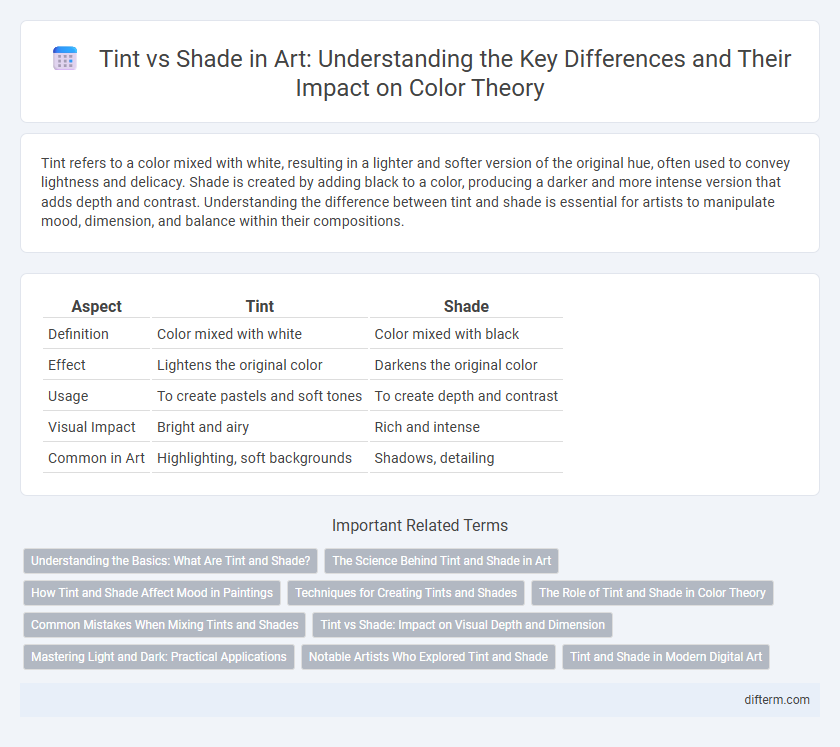Tint refers to a color mixed with white, resulting in a lighter and softer version of the original hue, often used to convey lightness and delicacy. Shade is created by adding black to a color, producing a darker and more intense version that adds depth and contrast. Understanding the difference between tint and shade is essential for artists to manipulate mood, dimension, and balance within their compositions.
Table of Comparison
| Aspect | Tint | Shade |
|---|---|---|
| Definition | Color mixed with white | Color mixed with black |
| Effect | Lightens the original color | Darkens the original color |
| Usage | To create pastels and soft tones | To create depth and contrast |
| Visual Impact | Bright and airy | Rich and intense |
| Common in Art | Highlighting, soft backgrounds | Shadows, detailing |
Understanding the Basics: What Are Tint and Shade?
Tint refers to a color mixed with white, resulting in a lighter and softer version of the original hue, while shade is created by adding black to a color, producing a darker and more intense variation. Both tint and shade are essential in art for creating depth, contrast, and visual interest within compositions. Mastering the use of tints and shades allows artists to manipulate mood and dimension effectively in their work.
The Science Behind Tint and Shade in Art
Tint and shade in art are defined by their relationship to a base hue, with tints created by adding white to lighten the color and shades produced by adding black to darken it. This process alters the color's value while maintaining its original hue, influencing depth, contrast, and emotional impact in artwork. Understanding the precise ratios of white or black mixed with pigments is essential for artists to control tonal variations and achieve the desired visual effects.
How Tint and Shade Affect Mood in Paintings
Tint adds lightness and softness to a color, often evoking feelings of calmness, tranquility, and openness in paintings. Shade introduces darkness and depth, creating a sense of drama, mystery, or intensity that can heighten emotional impact. Artists use tints and shades strategically to influence viewers' psychological responses and guide their interpretation of the artwork.
Techniques for Creating Tints and Shades
Techniques for creating tints involve mixing a pure color with white, which lightens the hue and increases its luminance without altering the color's inherent properties. To create shades, artists combine a pure color with black or a darker complementary color, deepening the tone and reducing brightness while maintaining color integrity. Mastery of these techniques enhances depth and dimension in artworks by controlling lightness and darkness effectively.
The Role of Tint and Shade in Color Theory
Tint and shade play crucial roles in color theory by altering a color's lightness and darkness to create visual depth and dimension. Tint is achieved by adding white to a base hue, increasing brightness and evoking a softer, lighter effect, while shade involves adding black, intensifying darkness and enhancing contrast. Artists utilize tints and shades to manipulate mood, emphasize focal points, and balance compositions within a color palette.
Common Mistakes When Mixing Tints and Shades
Confusing tints and shades often leads to muddy or unintended colors when mixing paints as a tint involves adding white to lighten a hue, whereas a shade requires adding black to darken it. Many beginners mistakenly add too much black when trying to create depth, resulting in dull or overly dark colors that lose the original vibrancy. Precise control of white and black ratios and understanding color temperature are crucial to avoid common mistakes and achieve desired artistic effects.
Tint vs Shade: Impact on Visual Depth and Dimension
Tint and Shade play crucial roles in enhancing visual depth and dimension by manipulating color lightness and darkness. Tint, created by adding white to a base color, produces lighter hues that can advance elements visually and create a sense of openness. Shade, formed by adding black, generates darker tones that recede surfaces, adding contrast and emphasizing volume in artistic compositions.
Mastering Light and Dark: Practical Applications
Tint involves adding white to a color to produce a lighter variation, ideal for highlighting and creating a sense of depth in artwork. Shade results from adding black to a color, enhancing shadow effects and adding dimensionality to compositions. Mastering the practical applications of tints and shades allows artists to effectively manipulate light and dark contrasts, enhancing realism and visual interest in their work.
Notable Artists Who Explored Tint and Shade
Notable artists like Rembrandt and Caravaggio mastered the use of shade to create dramatic contrasts and evoke deep emotional intensity in their paintings. Claude Monet and Pierre-Auguste Renoir employed tints extensively to capture light and atmosphere, enhancing the softness of their Impressionist works. These artists demonstrate how strategic manipulation of tint and shade contributes to the dynamic visual impact of fine art.
Tint and Shade in Modern Digital Art
Tint and shade in modern digital art play crucial roles in creating depth and mood by altering the lightness and darkness of colors respectively. Tints are produced by adding white to a base color, resulting in lighter, pastel-like hues that evoke softness and airiness in digital compositions. Shades, created by adding black, introduce richer, more intense tones that enhance contrast and realism, essential for dynamic and emotionally resonant artwork.
Tint vs Shade Infographic

 difterm.com
difterm.com